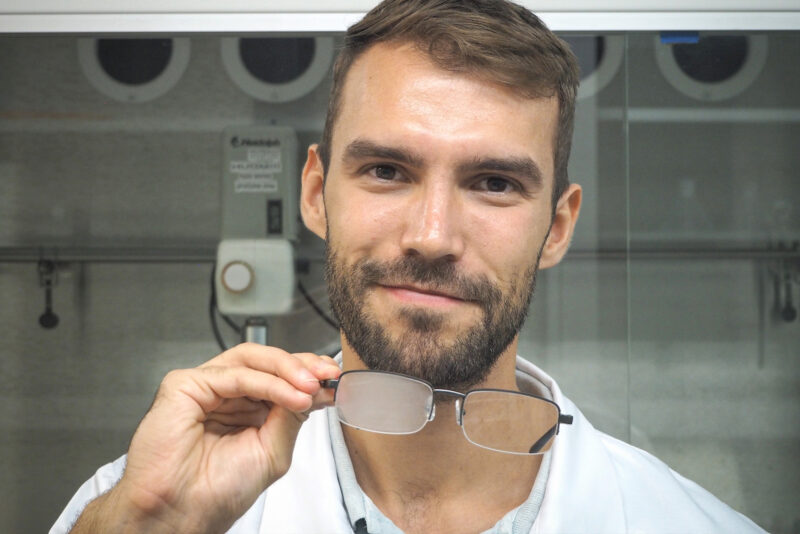Finnish researcher overcomes difficulties of processing lignin

Wood-based applications developed by Alexander Henn from Finland are a more ecological alternative to toxic chemicals in, for example, the automotive industry, says Finnish Natural Resources Research Foundation.
- Alexander Henn from Finland developed new wood-based solutions to replace toxic chemicals, such as synthetic PFAS substances.
- Henn proved that lignin, a component of wood, can be used for optical applications, including anti-fog coatings for eyeglasses or windscreens.
- Henn discovered that lignin can be used in so-called structural colouration in the automotive industry, for example.
- Awarded by the Finnish Natural Resources Research Foundation for his doctoral research, Henn also developed hybrid particles suitable for adhesives and the storing of heat.
A couple of years ago, Alexander Henn, then a doctoral student at Aalto University in Finland, and now a Doctor of Technology, was a bit worried about his thesis, according to the LINKKI press release by the Finnish Natural Resources Research Foundation.
With the final project to be included in the thesis, Henn wanted to develop a more ecological way of modifying the structure of lignin to make it more water-repellent.
The wood-based polymer lignin is extracted as a sidestream of forest industry. Using it efficiently is difficult because of its low solubility and reactivity and its heterogeneity.
Henn was concerned over the failure of some laboratory experiments. Instead of the intended four articles, Henn’s thesis would maybe only include three.
Transparent, anti-fog coating made of wood
Henn persevered with his experiments, and finally hit upon a process that worked. The result was a new, rapid and efficient method of bonding the water-binding structures of acetic acid and lignin to each other while preserving the water-repellent structures. He was then able to optimize the reaction to occur within minutes and at a temperature of only 60 degrees centigrade.
However, this was just the first step: Henn would now have to show that there was some point to it all. He processed the modified lignin into lignin particles. The hypothesis was that the particles would form a water-repellent coating. Henn poured the modified lignin solution into water, as he had done many times before with solutions of unmodified lignin.
(The story continues after the picture.)

He assumed the lignin would turn the mixture the colour of milky coffee. Yet the colour did not change.
’The dispersion was completely clear and transparent. I couldn’t figure this out. Was it that this modified lignin couldn’t be processed into particles? I studied it under a microscope and saw that it had worked all right. There were lignin particles in the solution, but so small that you couldn’t see them, and that’s why they didn’t affect the colour,’ Henn reports.
Henn tested the particles as coating, but they did not repel water. On the contrary, they were extremely hydrophilic, or attracted to water. This was explained by their structure. Most of the lignin had become more water-repellent, but as the particles were formed, a small part of the remaining water-binding groups had congregated on the particle surfaces.
Previously, Henn had read about the functionality of anti-fog coatings, and he remembered that they, too, were hydrophilic – contrary to what you would expect.
Understanding this made Henn change the goal of his experiment.
’I decided to test the anti-fogging capacity’, Henn says.
The experiment was an immediate success.
’I coated a small piece of glass to see whether it would fog up. It didn’t. You could say I was pleased,’ Henn reminisces.
I coated a small piece of glass to see whether it would fog up. It didn’t. You could say I was pleased.
Henn understood that the experiment had brought him to the brink of something quite unprecedented. Lignin, a component of wood, could be used in optical applications, such as anti-fog coatings for eyeglasses, windscreens and the like.
Described as ’revolutionary’ by Aalto University, this wood-based invention can replace some extremely toxic chemicals, such as the PFAS chemicals which are a threat to humans, animals and nature.
Henn’s discovery about the transparency of lignin was followed by another surprise. The colour of the lignin particles varied according to the film thickness. This is called ’structural colouration’, something that the Japanese company Lexus uses in its top-of-the-range cars.
’We first obtained a blue film, then a yellow one and finally mauve,’ Henn reports in the press release.
Awarded by Finnish Natural Resources Research Foundation
In April this year, Henn received a EUR 10,000 award for his doctoral thesis from the Finnish Natural Resources Research Foundation. Henn’s discoveries contribute to the move away from harmful fossil raw materials and also form a long-term carbon storage.
According to the statement of grounds for the award, Henn has in his doctoral thesis developed modification technologies which enable the processing of lignin into nanoparticles suitable for water-based applications. Among others, he used lignin to develop two types of coatings, an adhesive and particles suitable for heat storage.
In 2022 in Sweden, Henn won the Marcus Wallenberg Challenge for Young Researchers.
Henn’s research is part of the FinnCERES flagship programme funded by the Research Council of Finland.
